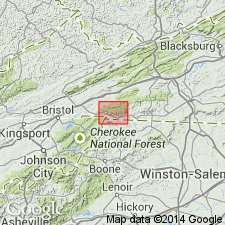
- Usage in publication:
-
- Whitetop Rhyolite Member*
- Modifications:
-
- Named
- Dominant lithology:
-
- Rhyolite
- AAPG geologic province:
-
- Appalachian basin
Summary:
Named as a member of Mount Rogers Formation in Mount Rogers volcanic center. Named for Whitetop Mountain, southwestern corner of Whitetop Mountain 7.5-min quad, southwestern VA. Previously called unit B by Rankin (1967) and Rankin and others (1974). Consists of high-silica rhyolite with grayish-purple or maroon, aphanitic groundmass and 0 to 10 percent phenocrysts of quartz and perthite in varying proportions. Characterized by chaotic flow layering, flow breccias, relict lithophysae in places, and pyroclastic rocks. Tuff breccia occurs at base of member on northwest side of saddle between Buzzard Rock and Whitetop Mountain. Breccia clasts include pieces of underlying Buzzard Rock Member (new name), other parts of Whitetop Rhyolite Member, and sparse clasts of basement gneissic granite. Tuff breccia, on north side of +4800-ft saddle through which Whitetop Mountain Rd passes, contains clasts of Whitetop Rhyolite Member, Buzzard Rock Member, porphyritic rhyolite resembling Fees Rhyolite Member (new name), greenstone, and gneissic granite. Estimated thickness on Whitetop Mountain is 500 m. Upper contact not preserved on Whitetop Mountain; underlain discontinuously by Buzzard Rock Member. Locally overlies Cranberry Gneiss. Age is Late Proterozoic. Report includes geologic map.
Source: GNU records (USGS DDS-6; Reston GNULEX).
For more information, please contact Nancy Stamm, Geologic Names Committee Secretary.
Asterisk (*) indicates published by U.S. Geological Survey authors.
"No current usage" (†) implies that a name has been abandoned or has fallen into disuse. Former usage and, if known, replacement name given in parentheses ( ).
Slash (/) indicates name conflicts with nomenclatural guidelines (CSN, 1933; ACSN, 1961, 1970; NACSN, 1983, 2005, 2021). May be explained within brackets ([ ]).

